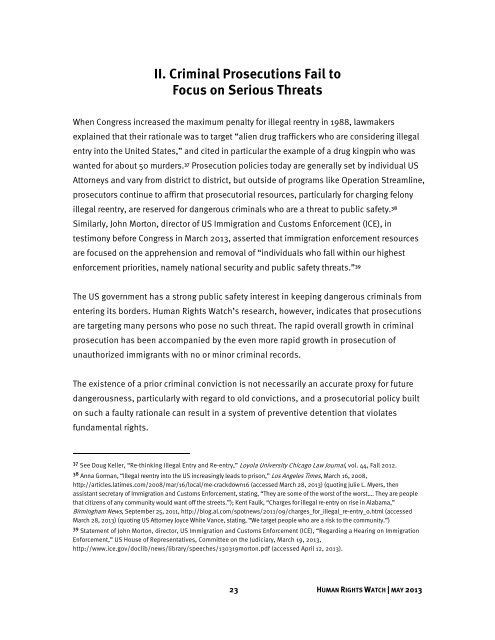Download the full report - Human Rights Watch
Download the full report - Human Rights Watch
Download the full report - Human Rights Watch
You also want an ePaper? Increase the reach of your titles
YUMPU automatically turns print PDFs into web optimized ePapers that Google loves.
II. Criminal Prosecutions Fail to<br />
Focus on Serious Threats<br />
When Congress increased <strong>the</strong> maximum penalty for illegal reentry in 1988, lawmakers<br />
explained that <strong>the</strong>ir rationale was to target “alien drug traffickers who are considering illegal<br />
entry into <strong>the</strong> United States,” and cited in particular <strong>the</strong> example of a drug kingpin who was<br />
wanted for about 50 murders. 37 Prosecution policies today are generally set by individual US<br />
Attorneys and vary from district to district, but outside of programs like Operation Streamline,<br />
prosecutors continue to affirm that prosecutorial resources, particularly for charging felony<br />
illegal reentry, are reserved for dangerous criminals who are a threat to public safety. 38<br />
Similarly, John Morton, director of US Immigration and Customs Enforcement (ICE), in<br />
testimony before Congress in March 2013, asserted that immigration enforcement resources<br />
are focused on <strong>the</strong> apprehension and removal of “individuals who fall within our highest<br />
enforcement priorities, namely national security and public safety threats.” 39<br />
The US government has a strong public safety interest in keeping dangerous criminals from<br />
entering its borders. <strong>Human</strong> <strong>Rights</strong> <strong>Watch</strong>’s research, however, indicates that prosecutions<br />
are targeting many persons who pose no such threat. The rapid overall growth in criminal<br />
prosecution has been accompanied by <strong>the</strong> even more rapid growth in prosecution of<br />
unauthorized immigrants with no or minor criminal records.<br />
The existence of a prior criminal conviction is not necessarily an accurate proxy for future<br />
dangerousness, particularly with regard to old convictions, and a prosecutorial policy built<br />
on such a faulty rationale can result in a system of preventive detention that violates<br />
fundamental rights.<br />
37 See Doug Keller, “Re-thinking Illegal Entry and Re-entry,” Loyola University Chicago Law Journal, vol. 44, Fall 2012.<br />
38 Anna Gorman, “Illegal reentry into <strong>the</strong> US increasingly leads to prison,” Los Angeles Times, March 16, 2008,<br />
http://articles.latimes.com/2008/mar/16/local/me-crackdown16 (accessed March 28, 2013) (quoting Julie L. Myers, <strong>the</strong>n<br />
assistant secretary of Immigration and Customs Enforcement, stating, “They are some of <strong>the</strong> worst of <strong>the</strong> worst…. They are people<br />
that citizens of any community would want off <strong>the</strong> streets.”); Kent Faulk, “Charges for illegal re-entry on rise in Alabama,”<br />
Birmingham News, September 25, 2011, http://blog.al.com/spotnews/2011/09/charges_for_illegal_re-entry_o.html (accessed<br />
March 28, 2013) (quoting US Attorney Joyce White Vance, stating, “We target people who are a risk to <strong>the</strong> community.”)<br />
39 Statement of John Morton, director, US Immigration and Customs Enforcement (ICE), “Regarding a Hearing on Immigration<br />
Enforcement,” US House of Representatives, Committee on <strong>the</strong> Judiciary, March 19, 2013,<br />
http://www.ice.gov/doclib/news/library/speeches/130319morton.pdf (accessed April 12, 2013).<br />
23 HUMAN RIGHTS WATCH | MAY 2013

















